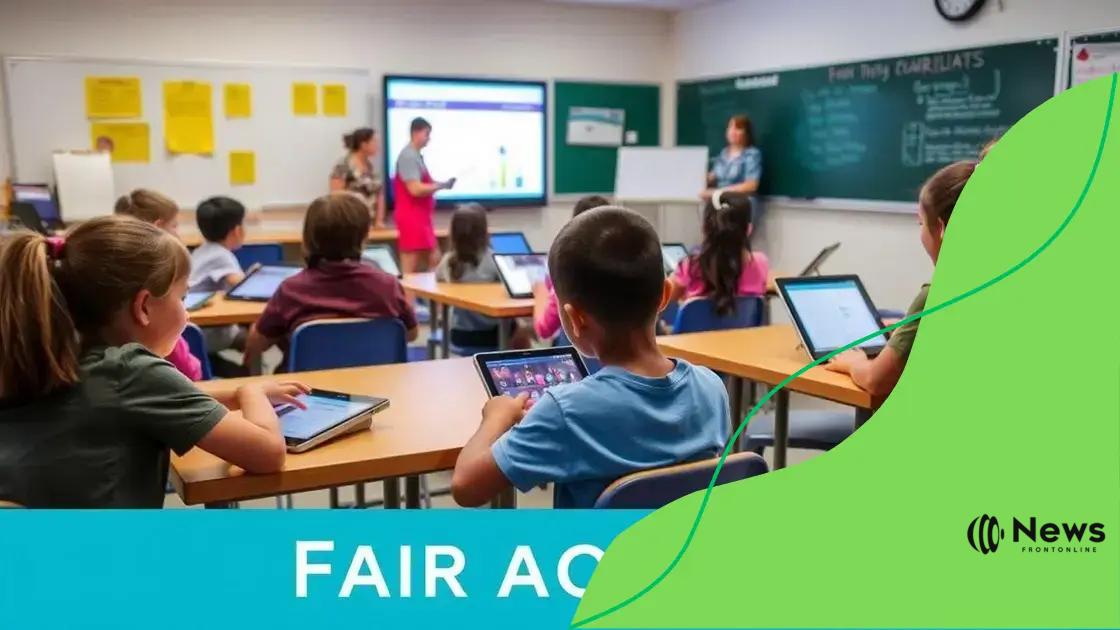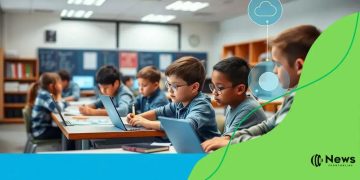Policies for fair access in virtual classrooms: why they matter
Policies for fair access in virtual classrooms ensure that all students have equal opportunities to engage in online learning by addressing challenges like the digital divide and promoting inclusive practices among educators.
Policies for fair access in virtual classrooms are essential for fostering an inclusive learning environment. Are you aware of how these policies can impact your education experience?
Understanding fair access in virtual classrooms
Understanding fair access in virtual classrooms is crucial for creating an inclusive educational environment. It ensures that all students, regardless of their background, have the resources and support they need to succeed.
What is Fair Access?
Fair access means that every student has an equal opportunity to participate in online learning. This includes access to technology, materials, and educational support.
Key Components of Fair Access
- Equitable Technology Availability: All students should have access to devices and reliable internet connections.
- Inclusive Curricula: Learning materials should cater to different learning styles and abilities.
- Support Services: Offering tutoring and mentoring to students who need extra help can bridge gaps in learning.
In addition to these components, schools must actively identify barriers to fair access. By recognizing issues like socioeconomic disparities, educators can implement solutions tailored to help affected students. Creating partnerships with community organizations can be beneficial in providing resources such as internet access and learning devices.
The role of teachers is also vital in promoting fair access. Educators should receive training on inclusive teaching practices. They can guide students on how to use technology effectively within the virtual learning environment.
The Importance of Community Engagement
Community involvement plays a key role in ensuring fair access. When families are engaged, it fosters a collaborative effort to support student learning. Parent-teacher associations can organize workshops to educate families about available resources and the necessity of maintaining an open line of communication.
Ultimately, striving for fair access promotes equity in education. It helps cultivate a learning atmosphere where every student can thrive, regardless of their circumstances. By focusing on these initiatives, educational institutions can pave the way for a more inclusive future.
Key policies promoting equality in online learning
Key policies promoting equality in online learning are essential for ensuring that all students have the same opportunities to thrive in a digital classroom. These policies help create a level playing field, allowing every learner to access valuable resources.
Access to Resources
One critical policy addresses the need for access to technology. Schools should provide devices and internet access to students who may not have them at home. This initiative can significantly reduce the digital divide.
Training for Educators
Another vital aspect of promoting equality is providing professional development for teachers. Educators should be trained on inclusive teaching practices that cater to diverse learning styles. This training can empower teachers to engage all students effectively.
- Culturally Relevant Teaching: Educators should incorporate materials that represent diverse backgrounds, making lessons relatable.
- Adaptive Learning Systems: Utilizing technology that personalizes learning can help meet individual student needs.
- Regular Assessments: Ongoing evaluations allow for timely interventions to support struggling students.
In addition to training, establishing clear communication channels is crucial. Schools should foster collaboration between families and educators to ensure that students receive the necessary support. Strong communication can bridge gaps and help identify specific needs.
Policy developers must also consider mental health resources as part of their equality initiatives. Providing access to counseling and emotional support services is vital for student well-being, especially in virtual environments.
Collaboration with Community Organizations
Engaging with local community organizations can enhance the effectiveness of policies promoting equality. These partnerships can offer additional resources and support systems for students and their families. When schools work together with local groups, they can create a network that better addresses students’ needs.
Ultimately, effective implementation of these policies can lead to an inclusive online learning environment where every student has the chance to succeed, regardless of their background or circumstances.
The role of technology in ensuring fair access

The role of technology in ensuring fair access cannot be overstated. In today’s educational landscape, technology serves as a bridge that connects students to resources and learning opportunities they might not have otherwise.
Improving Accessibility
Technology allows educators to create learning environments that adapt to various needs. For instance, using adaptive learning platforms can help tailor educational content to match individual student strengths and weaknesses.
Virtual Collaboration Tools
Another significant advancement is the rise of virtual collaboration tools. Platforms like video conferencing software enable students to connect with their peers and teachers from anywhere. This connection enhances participation and can improve overall learning outcomes.
- Ease of Communication: Students can easily reach out for help or clarification.
- Group Projects: Virtual tools allow seamless collaboration on assignments.
- Access to Experts: Students can engage with guest speakers or specialists from different fields.
Furthermore, using technology in the classroom encourages more interactive and engaging experiences. Applications and online platforms allow for gamified learning, keeping students motivated and interested. Implementing multimedia resources can also enhance understanding by catering to visual and auditory learners.
Despite these advantages, challenges still exist. Some students may lack access to reliable internet or devices. Schools must address these gaps to ensure that technology serves all students equally. By partnering with local organizations to provide devices or internet access, institutions can mitigate these issues.
Data-Driven Decisions
Technology also plays a critical role in gathering and analyzing data. Educators can track student progress more effectively and use this information to inform their teaching practices. By analyzing performance data, teachers can identify who may need additional support and implement timely interventions.
Ultimately, leveraging technology effectively can pave the way for a more inclusive learning environment. By ensuring that every student has access to the tools they need, we can create a brighter future for all learners.
Challenges in implementing access policies
Challenges in implementing access policies for fair access in virtual classrooms can hinder the effectiveness of educational initiatives. These obstacles can affect both students and educators, making it essential to identify and address them.
Digital Divide
One significant challenge is the digital divide. Many students lack access to reliable internet or devices needed for online learning. This issue is more pronounced in low-income areas, where families may not have the resources to afford technology.
Resistance to Change
Another challenge is the resistance to change from educators and institutions. Implementing new policies requires time and effort, and some educators may feel overwhelmed. They may not have the training needed to adjust their teaching methods to comply with new standards.
- Training Opportunities: Educators need proper training to understand and utilize new technologies effectively.
- Support Systems: Teachers may require additional support to feel confident in making changes to their teaching approaches.
- Administrative Buy-In: Leadership must be on board to allocate resources for new policy implementations.
Cultural differences can also play a role. Schools in diverse communities must consider the unique needs of their students. Understanding cultural contexts is crucial for developing effective policies that resonate with students from various backgrounds.
Beyond these barriers, there’s the concern of equitable funding. Even if a school creates access policies, limited budgets can restrict their effectiveness. Schools need sufficient funding to invest in technology, training, and ongoing support for educators and students.
Monitoring and Evaluation
Implementing access policies also requires continuous monitoring and evaluation. Schools need to assess whether these policies are achieving their intended goals. Data collection and analysis can highlight areas for improvement, but it often requires additional resources that schools may not have.
Addressing these challenges is crucial for successful policy implementation. By recognizing the obstacles, schools can begin to create more inclusive environments for all students, ensuring that fair access becomes a reality.
Best practices for educators and institutions
Best practices for educators and institutions play a vital role in promoting fair access in virtual classrooms. These strategies ensure that every student receives the support they need to thrive in an online learning environment.
Embrace Diverse Teaching Methods
One best practice is to embrace diverse teaching methods. Utilizing various approaches keeps students engaged and addresses different learning styles. Educators should consider incorporating visual aids, interactive tools, and hands-on activities in their lessons.
Foster an Inclusive Environment
Creating an inclusive environment is also crucial. Encouraging open dialogue and respect among students can help build a strong community. Teachers should ensure that all voices are heard and valued, promoting a sense of belonging.
- Encourage Participation: Use strategies that invite all students to contribute, such as small group discussions.
- Recognize Cultural Differences: Understand and incorporate students’ backgrounds into the curriculum.
- Provide Support Resources: Ensure students know where to find assistance, whether academic or emotional.
Additionally, educators should leverage technology to enhance learning. Using educational apps and online resources can make lessons more interactive, catering to students’ interests. Applying gamification elements can also motivate students to engage with the material.
Institutions must support educators by providing training and resources. Ongoing professional development is essential for teachers to stay updated on best practices and emerging technologies. School leaders should create workshops focused on inclusive practices and effective use of technology in the classroom.
Continuous Assessment and Feedback
Regular assessment and feedback are essential components of a successful learning environment. Educators should implement formative assessments that help identify students’ understanding in real time. Providing specific feedback allows students to recognize their strengths and areas for improvement.
By fostering adaptability and resilience, educators can help students navigate the challenges of online learning. Encouraging a growth mindset can motivate students to embrace their learning journey. Ultimately, by incorporating these best practices, educational institutions can create a dynamic and inclusive environment that champions fair access for all.
FAQ – Frequently Asked Questions about Fair Access in Virtual Classrooms
What is fair access in virtual classrooms?
Fair access refers to ensuring that all students have equal opportunities to participate in online learning, including access to technology and educational resources.
What challenges exist in implementing access policies?
Challenges include the digital divide, resistance to change from educators, and limited funding, which can all impact the effectiveness of access policies.
How can educators promote an inclusive environment?
Educators can promote inclusivity by encouraging open dialogue, recognizing cultural differences, and using diverse teaching methods that cater to various learning styles.
Why is training important for educators?
Training is crucial because it equips educators with the necessary skills and knowledge to effectively use technology and implement inclusive teaching practices.





